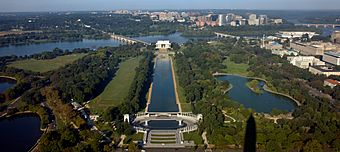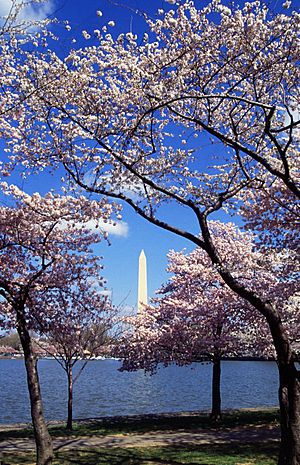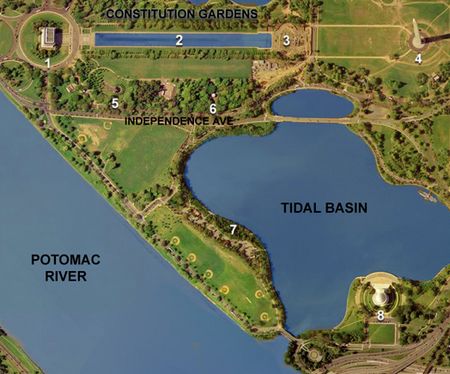West Potomac Park facts for kids
Quick facts for kids |
|
|
West Potomac Park
|
|
|
U.S. Historic district
Contributing property |
|

View of West Potomac Park (left) from the Washington Monument
|
|
| Location | Bounded by Constitution Ave., 17th St., Independence Ave., Washington Channel, Potomac River, and Rock Creek Park, N.W. |
|---|---|
| Area | 394.9 acres (159.8 ha) |
| Built | 1881-1912 |
| Part of | East and West Potomac Parks Historic District (ID73000217) |
| Designated CP | November 30, 1973 |
West Potomac Park is a special park in Washington, D.C.. It's managed by the National Park Service, which takes care of many important places in the U.S. This park is right next to the famous National Mall.
You can find West Potomac Park south of the Lincoln Memorial Reflecting Pool. It stretches from the Lincoln Memorial all the way to the area around the Washington Monument. Many important national landmarks are located here, like the Korean War Veterans Memorial, Jefferson Memorial, Franklin Delano Roosevelt Memorial, George Mason Memorial, and the Martin Luther King Jr. Memorial.
The park also includes the land around the Tidal Basin. This is a man-made body of water connected to the Potomac River. It was built a long time ago in the 1800s.
Contents
How West Potomac Park Was Created
Did you know that most of West Potomac Park didn't exist before 1882? Back then, a lot of downtown Washington, D.C., flooded badly in 1881. To fix this, the U.S. Congress told the Army Corps of Engineers to dig a deep channel in the Potomac River.
They used the dirt and mud from digging to fill in parts of the river. This created the riverbanks you see today. They also raised the land near the White House and along Pennsylvania Avenue by about 6 feet (1.8 meters)! Small ponds called Babcock Lakes were also filled in.
This new land, which included West Potomac Park, East Potomac Park, and the Tidal Basin, was mostly finished by 1890. In 1897, Congress officially named it Potomac Park. Later, in 1902, money was set aside to make the park beautiful. Workers planted grass, bushes, and trees. They also built sidewalks, paths for horses, and roads, and installed water pipes.
The Famous Cherry Trees

One of the most famous things about West Potomac Park is its beautiful cherry trees. These trees line the Tidal Basin and are the main attraction during the National Cherry Blossom Festival each spring. When the cherry blossoms bloom, it's a stunning sight!
The idea for planting cherry trees in Washington, D.C., came from a woman named Eliza Ruhamah Scidmore. After visiting Japan, she loved the cherry trees there. In 1885, she suggested planting them in Washington, but her idea was turned down. For the next 24 years, she kept asking different park superintendents, but nothing happened.
Then, in 1906, a botanist named Dr. David Fairchild brought 100 cherry trees from Japan. He planted them at his home in Chevy Chase, Maryland, to see if they would grow well in the Washington area. They did! In 1907, Dr. Fairchild and his wife started telling everyone that Japanese cherry trees would be perfect for Washington's streets.
In 1908, Dr. Fairchild gave cherry tree saplings to boys from schools in D.C. to plant on Arbor Day. He even said he hoped the "Speedway" (which is now Independence Avenue in West Potomac Park) would become a "Field of Cherries." Eliza Scidmore was there and Dr. Fairchild called her an expert on Japan.
In 1909, Eliza Scidmore decided to raise money to buy the trees herself and donate them to the city. She wrote a note to the new First Lady, Helen Herron Taft. Mrs. Taft had lived in Japan and knew how beautiful the cherry trees were.
Just two days later, Mrs. Taft wrote back, saying she loved the idea! She said she had already been promised some trees and thought they would look lovely along the road.
Soon after, a Japanese chemist named Dr. Jōkichi Takamine was in Washington. When he heard about the cherry trees, he asked if the First Lady would accept a gift of 2,000 more trees from Tokyo, Japan's capital city. Mrs. Taft happily accepted this generous offer.
However, there was a problem with the first gift of trees. When the 2,000 trees arrived in January 1910, experts found that they were full of insects and diseases. To protect American plants, the government had to destroy the trees. This was a sad moment for everyone, but Dr. Takamine was very understanding.
In 1912, Dr. Takamine kindly donated money for even more trees, increasing the number to 3,020! The seeds for these trees came from a famous collection in Japan. These are the beautiful cherry trees that bloom around the Tidal Basin today.
Fun Activities in the Park
West Potomac Park is also a place for sports! The West Potomac Rugby Football Club has its practice and game field located right in the park.
Map of West Potomac Park
Here's what you can find on the map:
|
Other important memorials and sculptures in the park include the George Mason Memorial, the Martin Luther King Jr. Memorial, the John Paul Jones Memorial, and the Arts of War and Arts of Peace sculptures.





